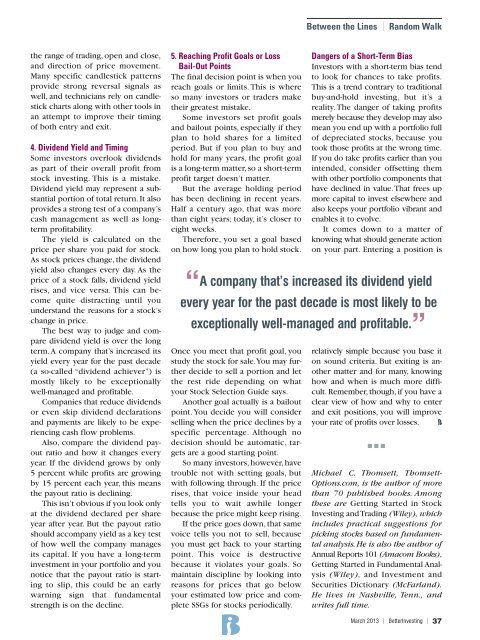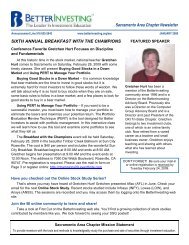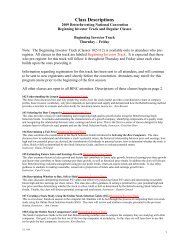STOCK TO STUDY: T. Rowe Price Group, Inc ... - BetterInvesting
STOCK TO STUDY: T. Rowe Price Group, Inc ... - BetterInvesting
STOCK TO STUDY: T. Rowe Price Group, Inc ... - BetterInvesting
You also want an ePaper? Increase the reach of your titles
YUMPU automatically turns print PDFs into web optimized ePapers that Google loves.
Between the Lines | Random Walk<br />
the range of trading, open and close,<br />
and direction of price movement.<br />
Many specific candlestick patterns<br />
provide strong reversal signals as<br />
well, and technicians rely on candlestick<br />
charts along with other tools in<br />
an attempt to improve their timing<br />
of both entry and exit.<br />
4. Dividend Yield and Timing<br />
Some investors overlook dividends<br />
as part of their overall profit from<br />
stock investing. This is a mistake.<br />
Dividend yield may represent a substantial<br />
portion of total return. It also<br />
provides a strong test of a company’s<br />
cash management as well as longterm<br />
profit ability.<br />
The yield is calculated on the<br />
price per share you paid for stock.<br />
As stock prices change, the dividend<br />
yield also changes every day. As the<br />
price of a stock falls, dividend yield<br />
rises, and vice versa. This can be -<br />
come quite distracting until you<br />
understand the reasons for a stock’s<br />
change in price.<br />
The best way to judge and compare<br />
dividend yield is over the long<br />
term. A company that’s increased its<br />
yield every year for the past decade<br />
(a so-called “dividend achiever”) is<br />
mostly likely to be exceptionally<br />
well-managed and profitable.<br />
Com panies that reduce dividends<br />
or even skip dividend declarations<br />
and payments are likely to be expe -<br />
riencing cash flow problems.<br />
Also, compare the dividend payout<br />
ratio and how it changes every<br />
year. If the dividend grows by only<br />
5 percent while profits are growing<br />
by 15 percent each year, this means<br />
the payout ratio is declining.<br />
This isn’t obvious if you look only<br />
at the dividend declared per share<br />
year after year. But the payout ratio<br />
should accompany yield as a key test<br />
of how well the company manages<br />
its capital. If you have a long-term<br />
investment in your portfolio and you<br />
notice that the payout ratio is starting<br />
to slip, this could be an early<br />
warning sign that fundamental<br />
strength is on the decline.<br />
5. Reaching Profit Goals or Loss<br />
Bail-Out Points<br />
The final decision point is when you<br />
reach goals or limits. This is where<br />
so many investors or traders make<br />
their greatest mistake.<br />
Some investors set profit goals<br />
and bailout points, especially if they<br />
plan to hold shares for a limited<br />
period. But if you plan to buy and<br />
hold for many years, the profit goal<br />
is a long-term matter, so a short-term<br />
profit target doesn’t matter.<br />
But the average holding period<br />
has been declining in recent years.<br />
Half a century ago, that was more<br />
than eight years; today, it’s closer to<br />
eight weeks.<br />
Therefore, you set a goal based<br />
on how long you plan to hold stock.<br />
Once you meet that profit goal, you<br />
study the stock for sale. You may further<br />
decide to sell a portion and let<br />
the rest ride depending on what<br />
your Stock Selection Guide says.<br />
Another goal actually is a bailout<br />
point. You decide you will consider<br />
selling when the price declines by a<br />
specific percentage. Although no<br />
decision should be automatic, targets<br />
are a good starting point.<br />
So many investors, however, have<br />
trouble not with setting goals, but<br />
with following through. If the price<br />
rises, that voice inside your head<br />
tells you to wait awhile longer<br />
because the price might keep rising.<br />
If the price goes down, that same<br />
voice tells you not to sell, because<br />
you must get back to your starting<br />
point. This voice is destructive<br />
because it violates your goals. So<br />
maintain discipline by looking into<br />
reasons for prices that go below<br />
your estimated low price and complete<br />
SSGs for stocks periodically.<br />
Dangers of a Short-Term Bias<br />
Investors with a short-term bias tend<br />
to look for chances to take profits.<br />
This is a trend contrary to traditional<br />
buy-and-hold investing, but it’s a<br />
real ity. The danger of taking profits<br />
merely because they develop may also<br />
mean you end up with a port folio full<br />
of depreciated stocks, because you<br />
took those profits at the wrong time.<br />
If you do take profits earlier than you<br />
intended, consider offsetting them<br />
with other portfolio components that<br />
have declined in value. That frees up<br />
more capital to invest elsewhere and<br />
also keeps your portfolio vibrant and<br />
enables it to evolve.<br />
It comes down to a matter of<br />
knowing what should generate action<br />
on your part. Entering a position is<br />
“<br />
A company that’s increased its dividend yield<br />
every year for the past decade is most likely to be<br />
exceptionally well-managed and profitable. ”<br />
relatively simple because you base it<br />
on sound criteria. But exiting is an -<br />
other matter and for many, knowing<br />
how and when is much more difficult.<br />
Remember, though, if you have a<br />
clear view of how and why to enter<br />
and exit positions, you will improve<br />
your rate of profits over losses.<br />
■ ■ ■<br />
Michael C. Thomsett, Thomsett -<br />
Options.com, is the author of more<br />
than 70 published books. Among<br />
these are Getting Started in Stock<br />
Investing and Trading (Wiley), which<br />
includes practical suggestions for<br />
picking stocks based on fundamental<br />
analysis. He is also the author of<br />
Annual Reports 101 (Amacom Books),<br />
Getting Started in Fundamental Anal -<br />
ysis (Wiley), and Investment and<br />
Secu rities Dictionary (McFarland).<br />
He lives in Nashville, Tenn., and<br />
writes full time.<br />
March 2013 | <strong>BetterInvesting</strong> | 37





